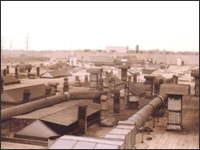|
|
 |
 |
|
INDUSTRIAL
|
-
The Problem: This plant was constructed with precast concrete "channel slab"
deck panels laid on steel framing. The deck panels are clipped and can move and
shift, creating an unstable roofing substrate.
-
Our Solution: After tearing-off the existing roofing, including careful
interior monitoring and protection of the assembly lines below, the deck panel joints
were resealed with roof cement and fabric. A one-ply base sheet/temporary roof
was then applied in hot asphalt, serving two functions:
-
The one-ply helps to "bridge" over the differences in panel elevation to create
a more uniform, level surface over which to apply the insulation boards.
-
The one-ply also served to minimize the effect of the panel movement on the
insulation boards of the new built-up roof system. Increasing the R-Value of
the new roof system insulation also reduced panel movement.
-
The Problem: The original flashing system at building expansion joints
were not designed to withstand the abuse caused by contractors and maintenance
personnel trafficing over the expansion joints.
-
Our Solution: The new roof flashing system at the expansion joints incorporated two-ply
modified bitumen flashings. Expansion joint covers were designed with hinged,
wood plank protection rails over the sheet metal expansion joint covers. Steel-grated ramps
were also included to make it easier to drag equipment over the expansion joints.
|
|
|
About IRS |
Our Services |
Contact Us |
Careers at IRS |
What's new at IRS |
Find a location |
Some of our projects |
Site Map
|
|